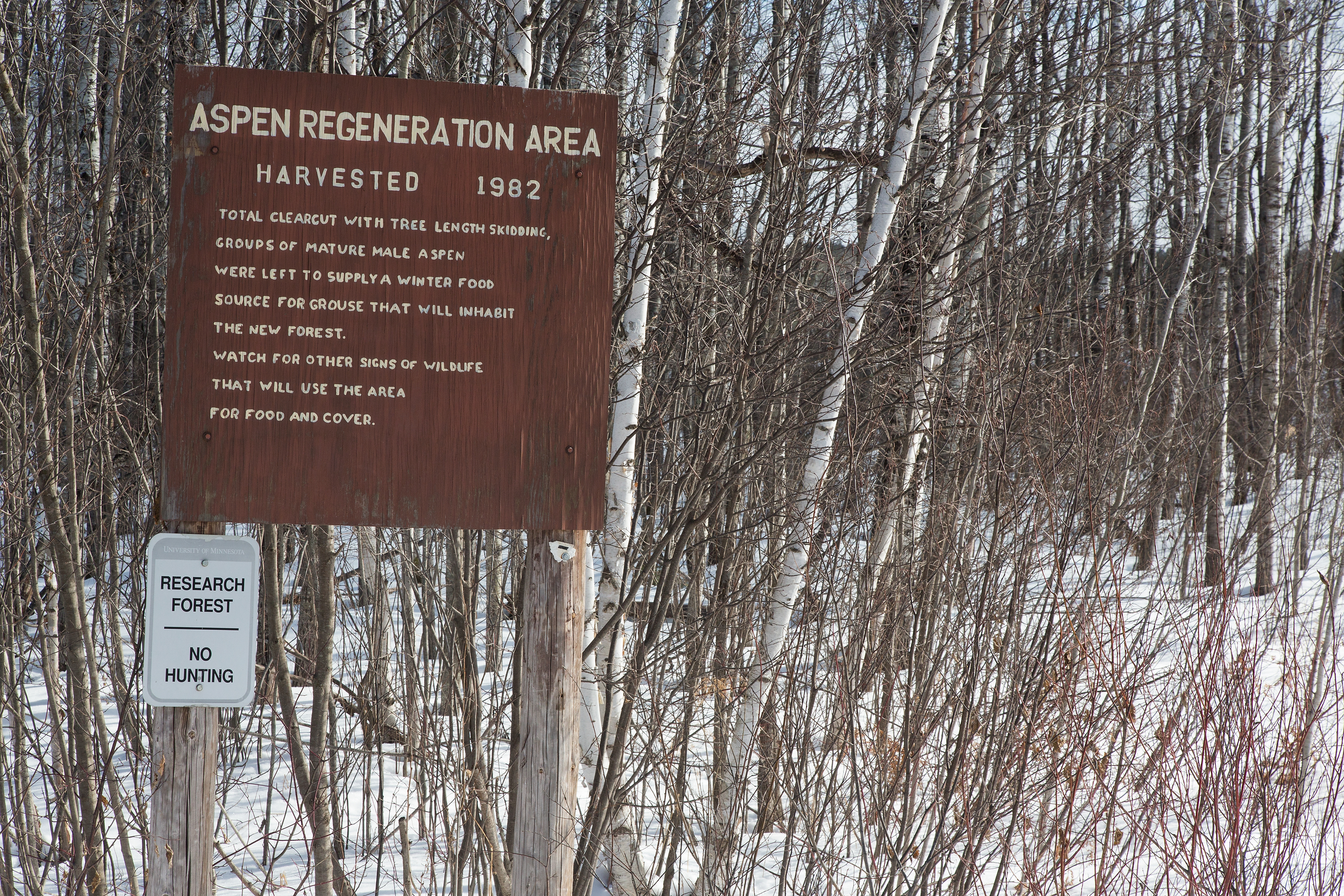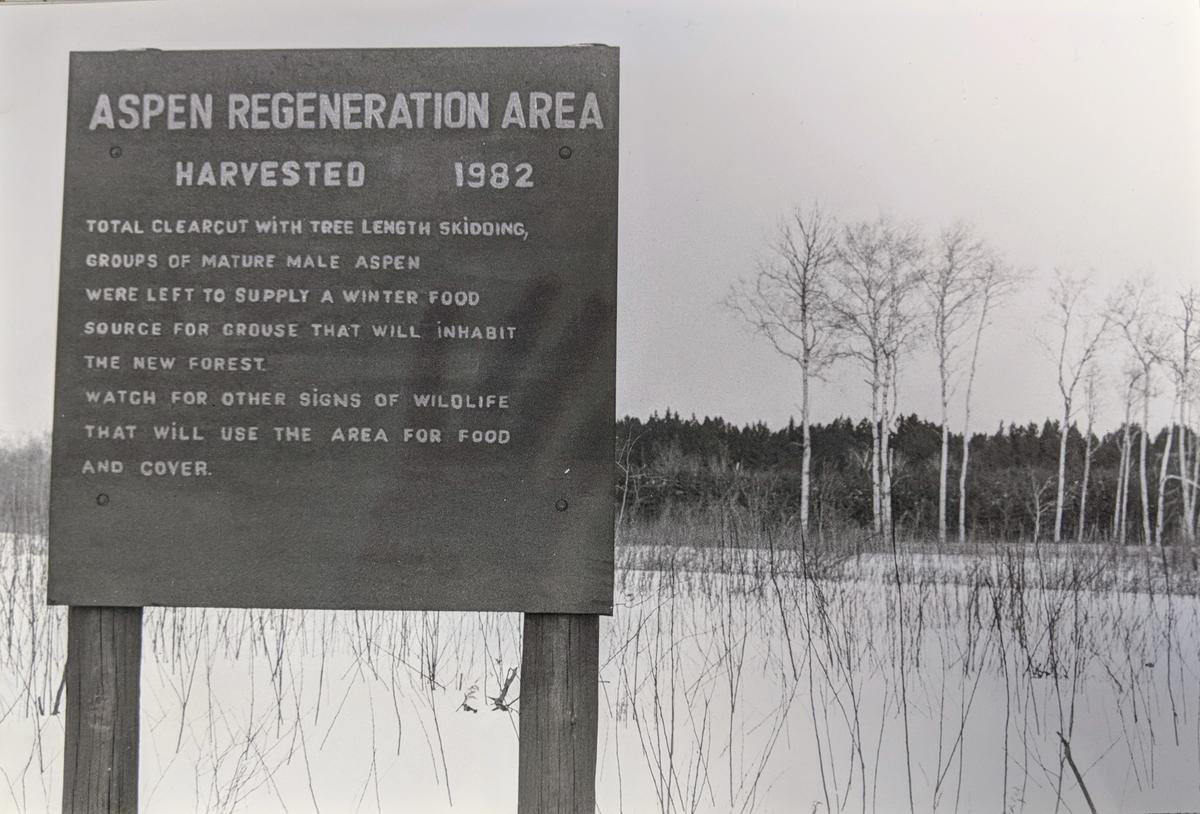Overview
Dr. Gordon Gullion, University of Minnesota wildlife professor from the 1950s through the early 1990s, established this experimental harvest as a way to promote ruffed grouse habitat using a clearcut with reserves (synonym: coppice-with-reserves) regeneration system. A majority of the stand was clearcut though four groups of mature male aspen were reserved for forage and cover, effectively creating a two-aged stand.

Figure 1: Gullion treatment signpost 1984
Silviculture Objective(s)
According to his research proposal, Dr. Gullion sought to use the opportunity of scheduled cuts of mature aspen to examine the viability of “preserving mature male aspens in small clumps in order to allow a grouse population to persist within extensive aspen clear-cuts.” Based on studies carried out in the area, Dr. Gullion was confident that “leaving perhaps as few as 50 to 100 mature male aspens standing [would] allow grouse to remain in areas from which they would otherwise be excluded when the clear-cuts exceed 10 acres in size.”
Pre-treatment stand description and condition
Stand establishment and management history:
Historical land-use records suggest that this stand established around 1909 following the first documented merchantable-timber cutover. No specific management actions, such as planting or seeding, were recorded prior to the winter 1982-1983 clearcut-with-reserves harvest documented in this case study.
Pre-treatment species composition:
According to the 1977 covertype map (see Supplementary Material [S] 1), the treatment area basal area was primarily greater than 67% aspen in the 5-8.9” DBH class with 40-70% crown closure, which suggests the overall site quality is poor for growing aspen. Field-based observations and digital elevation data show that the much of the stand is very close to the water table, which is assumed to contribute to the low site quality. There was also a small stand of jack pine in the 9-14.9” DBH class with 40-70% crown closure in the northern portion of the treatment area. The pre-treatment stand cruise tallied aspen, jack pine, Scotch pine, and paper birch (see S2); though not picked up in the cruise, the harvest report indicates that red and white pine was also a minor compositional component. See Supplemental Materials.
Pre-treatment growth and stocking:
The pre-treatment stand was estimated to be of relatively low basal area and volume. The total estimated basal area of the harvest area was 44 ft2/ac and the total volume to be removed was estimated to be around 308 cords or 14.7 cd/ac. Aspen BA was estimated to be around 36 ft2/ac, or 82% of total BA. Jack pine BA was estimated to be around 8 ft2/ac. The aspen averaged around 3.5 eight-foot sticks per tree and the jack pine averaged around 5.1 eight-foot sticks per tree. The total volume removed (See Table 1) indicates that a total of 366 cords, or 17 cd/ac, were removed. Of this, aspen represented 57%, jack pine 39%, paper birch 3%, and red and white pine 1%. The discrepancy between percentages of aspen when comparing estimated BA and volume removed likely has to do with a combination of two factors: 1) there were four groups of aspen reserved from harvest, and 2) the jack pine diameters were, on average, greater so likely a larger part of the volume.


Figures 2 & 3: One of four groups of mature aspen reserved in the harvest area in 1984
Table 1: Timber sale volume and revenue from the 1983 harvest. Volume units are cords unless otherwise noted.
|
Product |
Volume |
Price/cd |
Total |
|---|---|---|---|
|
Aspen Pulp |
210.14 |
$2.50/cd |
$525.35 |
|
Jack Pine Bolts |
80.76 |
$16.87/cd |
1,362.42 |
|
Jack Pine Pulp |
60.46 |
$8.88/cd |
$536.88 |
|
Red & White Pine Sawlogs |
2.68 MBF |
$66.60/mbf |
$178.49 |
|
Birch Fuelwood |
9.50 |
$2.50/cd |
$23.75 |
|
$2,626.89 |
Pre-treatment forest health issues:
No forest health issues were recorded. Standing water is visible during periods of high water, especially during spring, because the ground surface and water table are quite close to each other.
Landowner objectives/situation:
The Cloquet Forestry Center (CFC) has been the research, teaching, and experimental forest for the University of Minnesota since 1909. Part of the mission and objectives of the CFC, per the 2016-2025 Management Plan, are to initiate and support ongoing research related to northern forests, to maintain a diversity of cover types and age classes, and to increase the quality, functionality, and quantity of wildlife habitat. Although the clearcut-with-reserves treatment in this case study currently seems pretty standard, reserving groups of trees with the specific functional purpose of providing forage for ruffed grouse was novel and experimental in 1983. This case study not only brings to light the importance of long-term records for documenting how plant communities change but also how land management objectives and techniques evolve over time; one day’s novelty is another day’s compulsory.
Silviculture Prescription
Total clearcut all species 4” DBH and larger except for 4 small clumps of mature male aspen to provide habitat and food for ruffed grouse. Random skidding must be done to knock down the heavy brush understory and any unmerchantable trees. The harvesting should allow a well-stocked, mostly even-aged aspen stand to establish on the site. Regeneration should be minimally affected by the reserve groups.
What actually happened during the treatment
All live trees 5” DBH and larger were skidded to the designated landing. Random skidding was carried out in order to cause maximum brush disturbance over the entire sale area. Limbs, tops, and any and all other unmerchantable parts of trees were cut so that they lay within 12 inches of the ground. Four groups of trees were left undisturbed by every phase of the timber harvesting process. Trees less than 5” DBH were cut so that bole, limbs, and tops lay within 12 inches of the ground.
Post-treatment assessment
The stand was cruised in 2018, 35-years post treatment, and found to be very much dominated by aspen. There was an average of 271 live trees per acre across the stand, of which only 11 and eight trees per acre was green ash and red maple, respectively; there were 24 snags per acre (see S3). There is approximately 74 ft2ac-1 of live tree basal area (see S4). There is a thick understory layer of beaked hazel (Corylus cornuta) throughout the stand roughly 8 to 10 feet tall. There was much downed coarse woody debris scattered throughout the stand that ranged from roughly 2-8 inches in diameter (ocular estimate).

Figure 4: Stand conditions 36 years following harvest
The reserve clumps retained in 1983 are somewhat identifiable in the stand, if you know what to look for. Many of the trees have fallen over and become coarse woody debris. Ruffed grouse usage assessments up until 2011 suggest the area has been utilized.

Figure 5: Interpretive sign in the foreground of the treatment area 36 years after treatment.
Plans for future treatments
No specific future treatments have been planned at this time. Potential options include perpetually managing as an aspen site and promoting habitat for grouse. The next step in that scenario could incorporate thermal cover conifers, such as white spruce.
Given that the site appears to primarily be producing low-quality aspen, another option could be to manage the stand away from aspen in favor of other tree species that may be a better fit to the abiotic characteristics of the site, such as tamarack (Larix laricina) or black ash (Fraxinus nigra).
Additionally, this stand could be considered for a climate-adapted lowland forest species trial including species such as silver maple, swamp white oak, box elder, and slippery elm.
Costs and economic considerations
Not fully known due to time since treatment and personnel changes. See Table 1 for valuation of the timber.
Summary / lessons learned / additional thoughts
The treatment went as planned. Unfortunately, the one-to-one relationship between grouse and the treatment was not directly tracked, though Dr. Gullion’s research on ruffed grouse populations continued across the stand and entire forest; results can be found in various publications and books1. Cover from conifers and drumming logs are important resources for grouse that were not specifically considered in this treatment; likely, it was assumed that these resources were being provided for in other or it was thought that these resources would develop on their own. The 2018 sample of the stand demonstrates that snags and deadwood are starting to appear but that there is no measureable conifer component. Given this, intentional establishment of white spruce or balsam fir at the time of harvest could have been beneficial to both canopy composition diversity and structural features that benefit ruffed grouse.
This historical record of one of the first timber harvest prescriptions on record with specific wildlife considerations offers a number of lessons.
1) Guidelines for retention are very much different now than in the early 1980s. The amount of retention in this prescription would probably be considered low or normal by 2018 standards.
2) Prescriptions, or components of prescriptions, that prioritize wildlife habitat creation are more common than they were in the early 1980s. This demonstrates a healthy shift towards management objectives that are more diversified than simply producing timber.
3) the low-quality of timber being produced in this stand – three to four-stick aspen – indicates that this is a good location for prioritizing non-timber production objectives or conversion to a forest community better adapted to the abiotic conditions of the site. And,
4) reserving clumps of aspen on this site does not appear to alter the quality or or reduce the quantity of aspen regeneration.
1 – Cloquet Forestry Center Research Papers and Reports, 1912 – 2011 can be found on the UMN Department of Forest Resources website; last accessed February 7, 2019
Supplemental content
Large supplemental content document for this case study
Submitted by
Kyle Gill
Kyle has been the CFC forest manager and research coordinator since 2015. He enjoys exploring stand development, silviculture, and the inherent biases that we bring to decision making. He feels it is important to see himself and other humans as community members of forested and non-forested ecological communities.
Lane Moser
Lane got his passion for silviculture over the course of achieving his B.S. and M.S. in forestry from the University of Minnesota. He has worked at the Sustainable Forests Education Cooperative since early 2022. Lane is also currently pursuing a PhD at the University of Minnesota; his specialization and research interests include both silviculture and soil health and structure, particularly as they relate to the aspen cover type.
